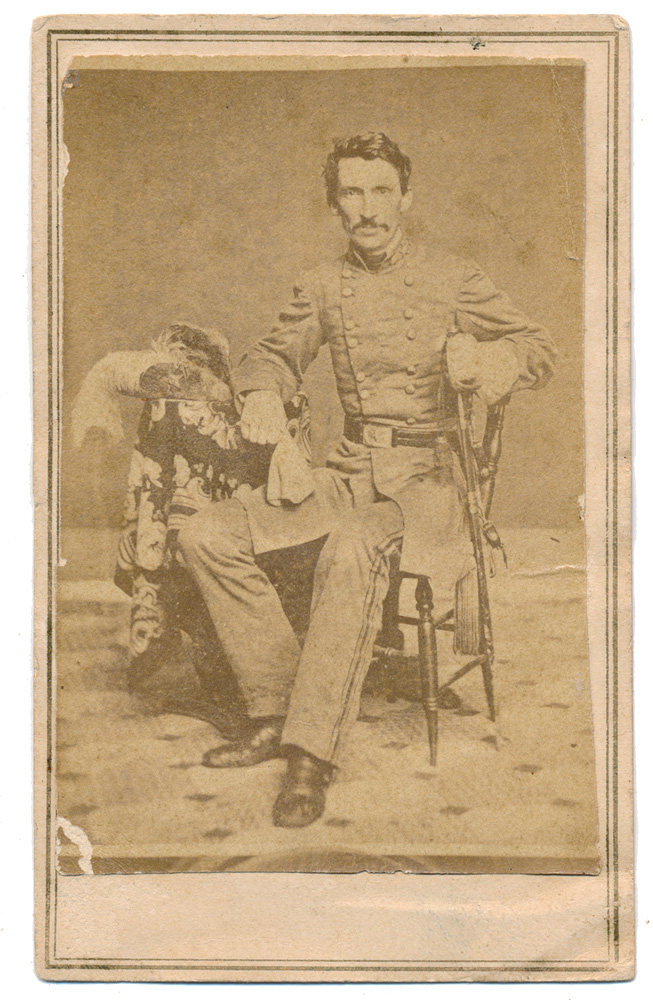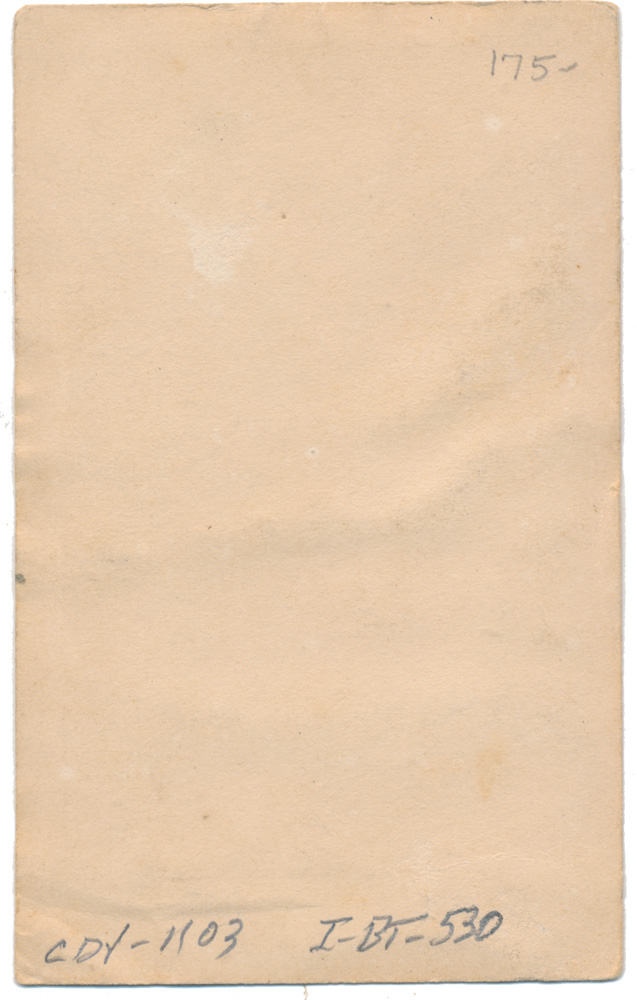site search
online catalog
SEATED VIEW OF MISSOURI GENERAL M. JEFF THOMPSON

Hover to zoom


$395.00 SOLD
Quantity Available: None
Item Code: 1138-530
CDV shows Thompson seated at a table. He is posed with one arm resting on the table and holding a gauntlet while the other hand rests on the hilt of his sword. Next to him on the table is his slouch hat festooned with a five-pointed star and an ostrich plume. The General wears light-colored double-breasted frockcoat and matching trousers with a dark leg stripe. His rank is clearly visible on the collar of his coat. He also wears a waistbelt with a rectangular Pattern 1851 plate and sash with his Model 1850 Foot Officer’s sword attached.
Contrast and clarity are good. Paper and mount have light surface wear.
Reverse is blank but for collector information in pencil.
Photo is from the collection of the late William A. Turner.
Meriwether Jefferson Thompson was born in Jefferson County, Virginia on January 22, 1826 into a family with a strong military tradition. He received basic training in military tactics in Charleston, South Carolina, but was not appointed to a military academy. Following his education, he found employment as a store clerk in a few Virginia and Pennsylvania towns. He moved to Liberty, Missouri, in 1847 and St. Joseph the following year, continuing work as a store clerk before taking up surveying and serving as the city engineer. He later supervised the construction of the western branch of the Hannibal & St. Joseph Railroad. He married Emma Catherine Hays in 1848 and served as the seventh Mayor of St. Joseph, Missouri from 1857 to 1860. He presided over the ceremony inaugurating the first ride of the Pony Express on April 3, 1860 and gained national attention in May, 1861. It was then that he cut down a United States flag from the St. Joseph Post Office flag pole and threw it down to an angry crowd of southern sympathizers who shredded it to pieces.
Thompson was a lieutenant-colonel in the Missouri state militia at the outbreak of the Civil War. On July 25, 1861, he was appointed brigadier-general of the 1st Division, Missouri State Guard. He commanded the First Military District of Missouri, which covered the swampy southeastern quarter of the state from St. Louis to the Mississippi River. Thompson's battalion soon became known as the "Swamp Rats" for their exploits. Although Thompson frequently petitioned for the Confederate rank of brigadier-general it was never granted. His brigadier rank came from his Missouri State Guard service.
When Union Major-General John C. Fremont issued an emancipation proclamation purporting to free the slaves in Missouri, Thompson declared a counter-proclamation and his force of 3,000 soldiers began raiding Union positions near the border in October. On October 15, 1861, Thompson led a cavalry attack on the Iron Mountain Railroad bridge over the Big River near Blackwell in Jefferson County. After successfully burning the bridge, Thompson retreated to join his infantry in Fredericktown. Soon afterwards, he was defeated at the Battle of Fredericktown and withdrew, leaving southeastern Missouri in Union control.
After briefly commanding rams in the Confederate riverine fleet in 1862, Thompson was reassigned to the Trans-Mississippi region. There, he engaged in a number of battles before returning to Arkansas in 1863 to accompany Gen. John S. Marmaduke on his raid into Missouri. Thompson was captured in August in Arkansas, and spent time in St. Louis' Gratiot Military Prison, as well as at the Fort Delaware and Johnson's Island prisoner-of-war camps.
Thompson was exchanged in 1864 and later that year he participated in Major-General Sterling Price's Missouri expedition, taking command of "Jo" Shelby's famed "Iron Brigade" when Shelby became division commander. He served competently in this role.
In March 1865, Thompson was appointed commander of the Northern Sub-District of Arkansas. He agreed to surrender his command at Chalk Bluff, Arkansas on May 11, 1865, and agreed to have his men lay down their arms and receive their paroles. Thompson's command was widely dispersed throughout northeast Arkansas, more for reasons of available forage than anything else. About a third of his men refused to surrender. Shelby's Missouri Brigade, along with elements of Green's and Jackman's Missouri brigades, lit out for Mexico. Some Missouri units disbanded rather than surrender their colors. Many men simply went home.
After the Civil War, Thompson moved to New Orleans, where he returned to civil engineering. He designed a program for improving the Louisiana swamps, a job that eventually destroyed his health. He returned to St. Joseph, Missouri in 1876 where he succumbed to tuberculosis. He is buried in Mount Mora Cemetery in St. Joseph, Missouri. [ad] [ph:L]
~~~~~~~~~~~~~~~~~~~~~~~~~~~~~~~~~~~
THIS ITEM, AS WITH ALL OTHER ITEMS AVAILABLE ON OUR WEB SITE,
MAY BE PURCHASED THROUGH OUR LAYAWAY PROGRAM.
CLICK HERE FOR OUR POLICIES AND TERMS.
THANK YOU!
Inquire About SEATED VIEW OF MISSOURI GENERAL M. JEFF THOMPSON
Most Popular
Historical Firearms Stolen From The National Civil War Museum In Harrisburg, Pa »
Theft From Gravesite Of Gen. John Reynolds »
Selection Of Unframed Prints By Don Troiani »
Fine Condition Brass Infantry Bugle Insignia »
featured item
1847 CONGRESSIONAL RESOLUTIONS OF THANKS TO GEN. ZACHARY TAYLOR AND HIS OFFICERS AND MEN FOR MONTERREY, PERSONALLY DISPATCHED BY PRESIDENT POLK
Zachary Taylor received the formal thanks of Congress three times, along with gold medals, for victories in the Mexican War, the largest number of such resolutions and awards made by Congress to anyone. This is an official State Department copy on… (766-938). Learn More »
site search
Upcoming Events
The shop is currently closed so that we may conduct our annual inventory. We are available by phone… Learn More »


